Ever felt completely lost among endless cold summer options?
You’re craving something Japanese, but udon, soba and somen all seem to blend into one another. This cold kitsune soba cuts through the confusion with perfect simplicity: Silky buckwheat noodles meet sweet, pillowy fried tofu in a refreshing combination.
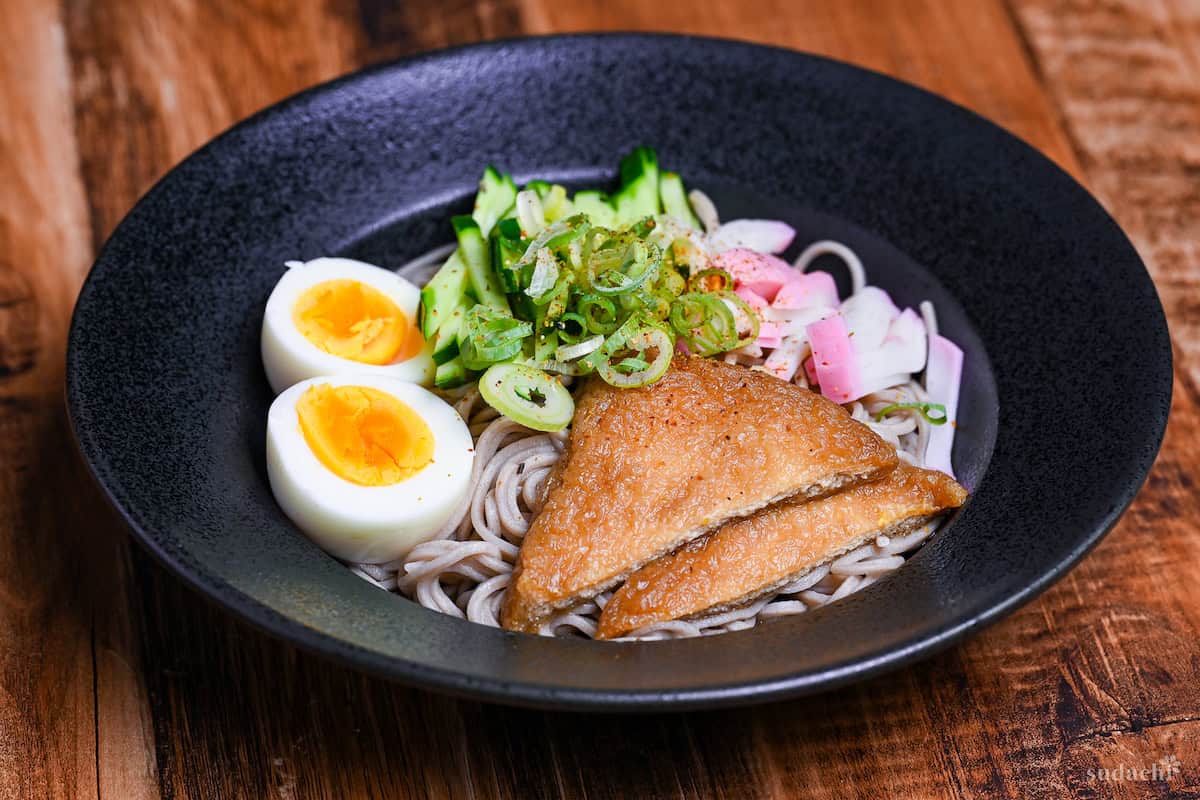
I’ll talk you through every step of the process of transforming simple ingredients into restaurant-quality summer comfort.
Key Ingredients & Substitution Ideas
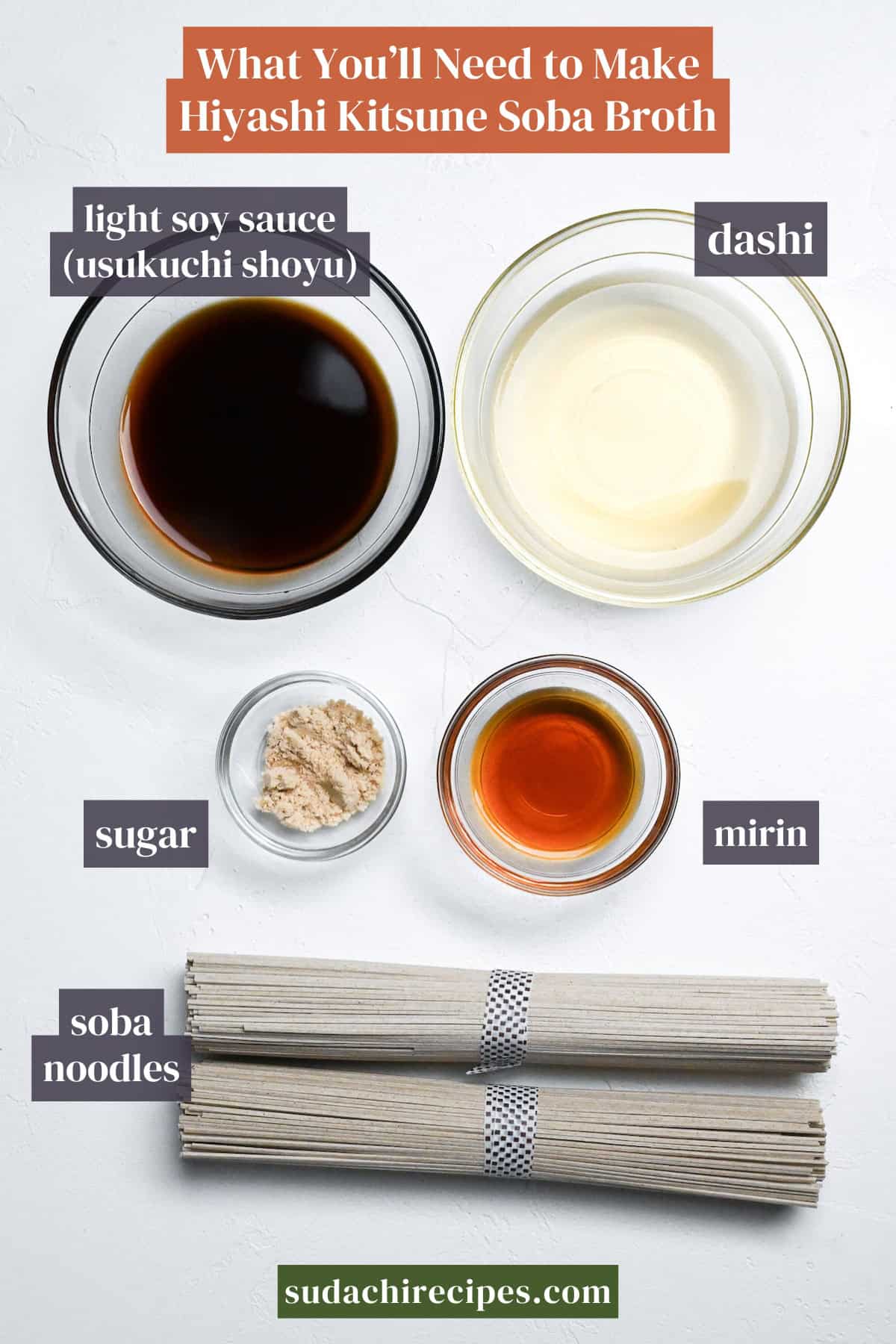
- Dashi Stock: I used a classic combination of katsuobushi (bonito flakes) and kombu blended dashi. If you’re going plant-based or just curious to explore, a kombu and dried shiitake mushroom blend gives surprisingly deep flavor. Short on time? Dashi packets will be your solid shortcut.
- Japanese Light Soy Sauce (Usukuchi Shoyu): To keep the broth clear and gentle in flavor, I went with light soy sauce. If you only have regular Japanese soy sauce (koikuchi), that works too. Just expect a slightly deeper color and rounder taste.
- Soba Noodles: Dried soba works fine here. If you’re feeling adventurous, homemade soba is a fun weekend challenge!
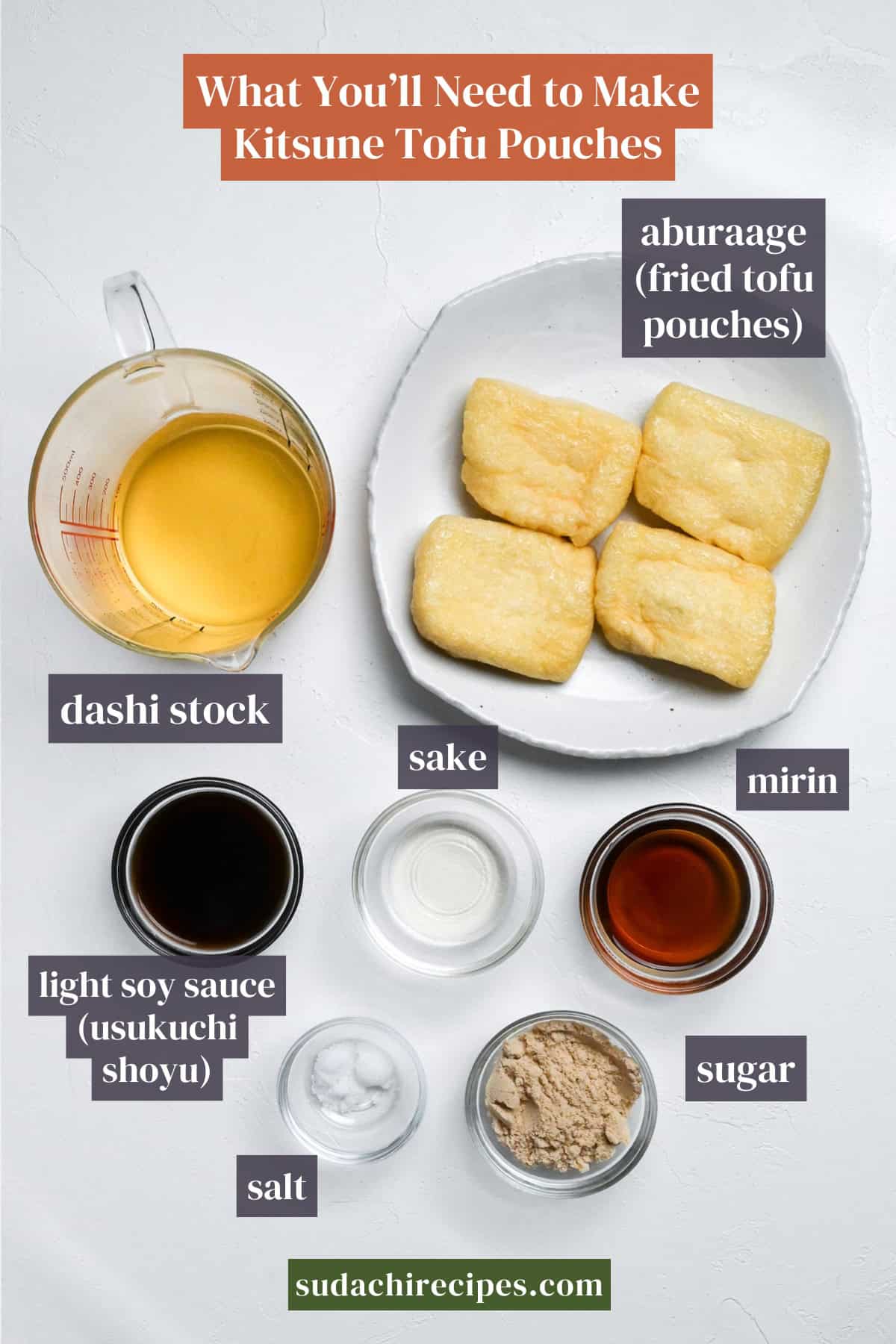
- Fried Tofu Pouches (Aburaage): Without these golden pouches, you simply can’t make authentic kitsune soba. You’ll find them in the refrigerated section of Japanese or Asian supermarkets near the regular tofu. For the adventurous, there’s even a way to make aburaage from scratch.
- Sugar: I used light brown sugar, but regular white sugar works just fine if that’s what you’ve got on hand.
Visual Walkthrough & Tips
Here are my step-by-step instructions for how to make Hiyashi Kitsune Soba at home. For ingredient quantities and simplified instructions, scroll down for the Printable Recipe Card below.
This section aims to provide a comprehensive overview of the cooking steps and techniques with visuals. It also includes more in-depth tips and tricks and explains why I do what I do.
Fill a medium saucepan with enough water to cover the abura-age and bring it to a rolling boil. Add salt and gently slide the aburaage into the water.
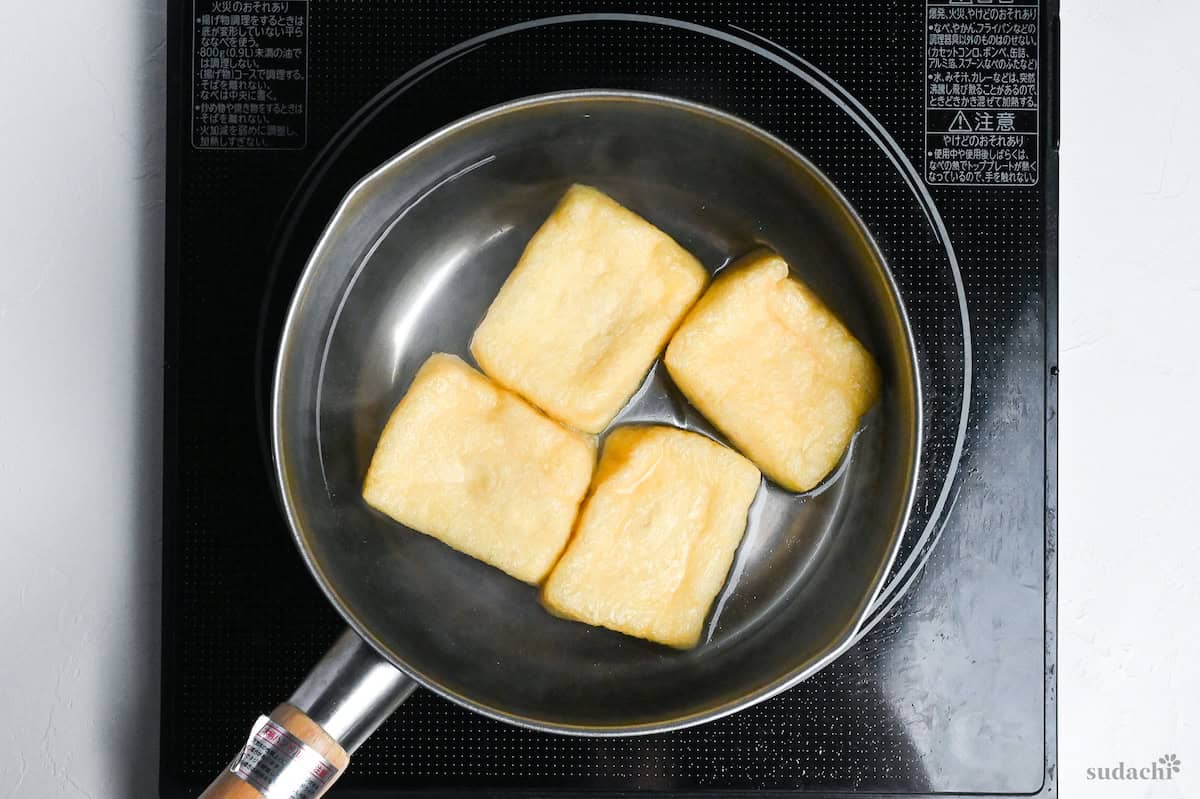
Place a drop lid (otoshibuta) or foil directly on top of the tofu pouches to keep them submerged, then blanch for exactly 3 minutes.
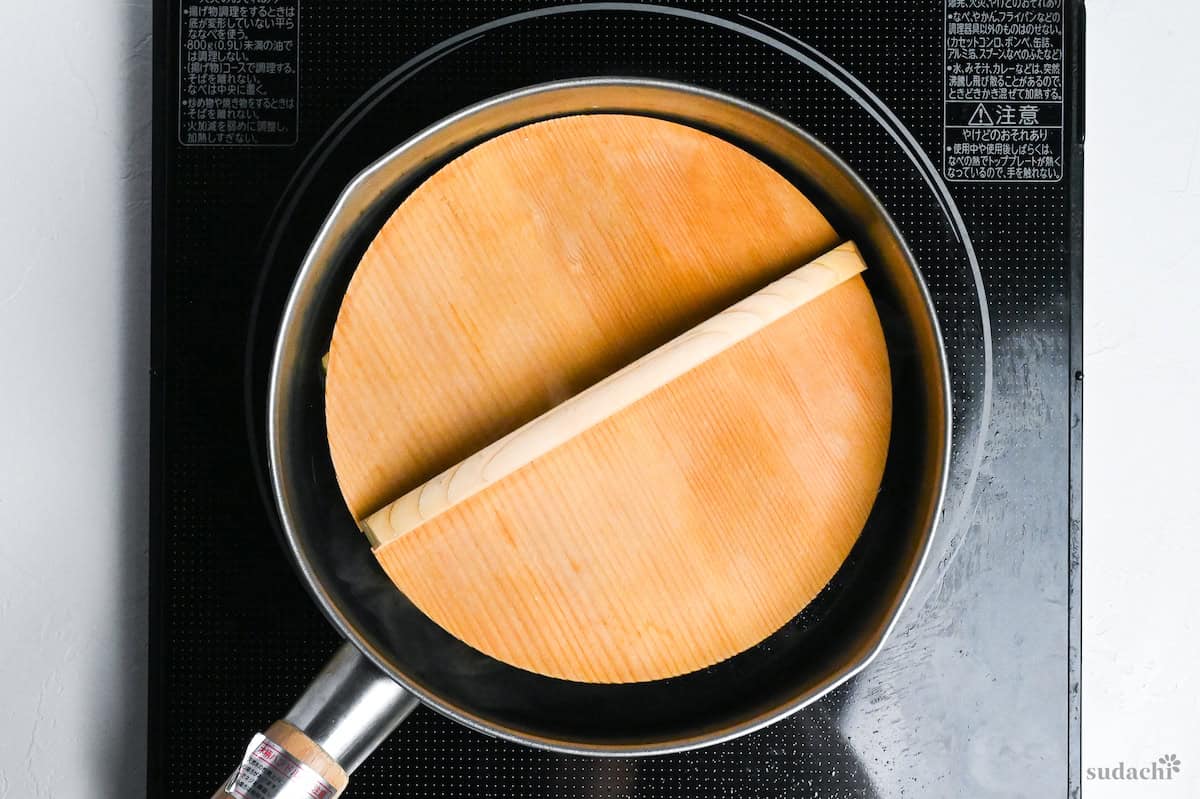
Fresh aburage contains manufacturing oils that prevent flavor absorption. If you skip blanching, you’ll end up with pouches that taste like sweet-and-salty sauce is sitting on top of them rather than being soaked through.
The hot water purge also eliminates any lingering oil odors, leaving you with clean tofu that is ready to be seasoned and will absorb your simmering liquid like a sponge.
Lift the abura-age from the hot water and immediately rinse under cold running water until cool to the touch.
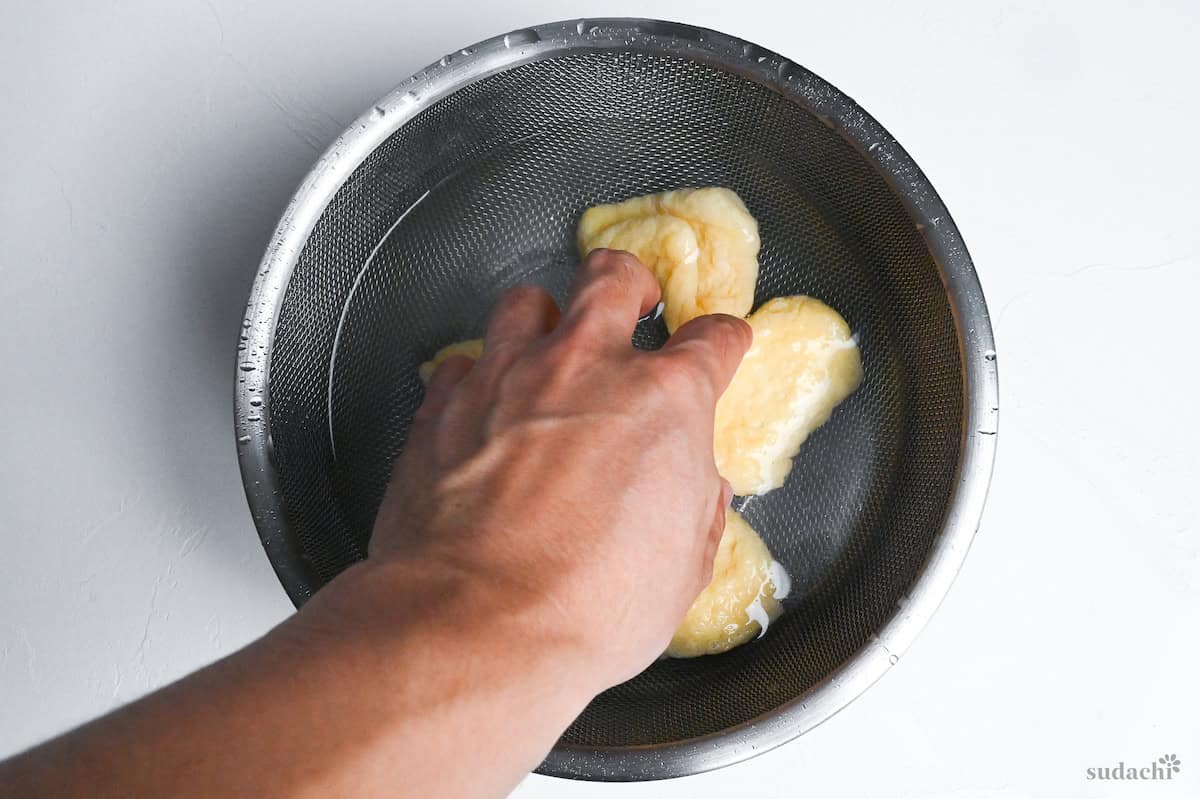
Gently squeeze each piece between your palms to press out excess moisture. You’ll feel the pouches deflate slightly as trapped water escapes.
Be firm but not aggressive here. You want to remove water without tearing the delicate tofu skin.
In a clean saucepan, combine the dashi stock, sugar, sake, and mirin. Stir everything together over medium heat, watching for the sugar crystals to completely dissolve.
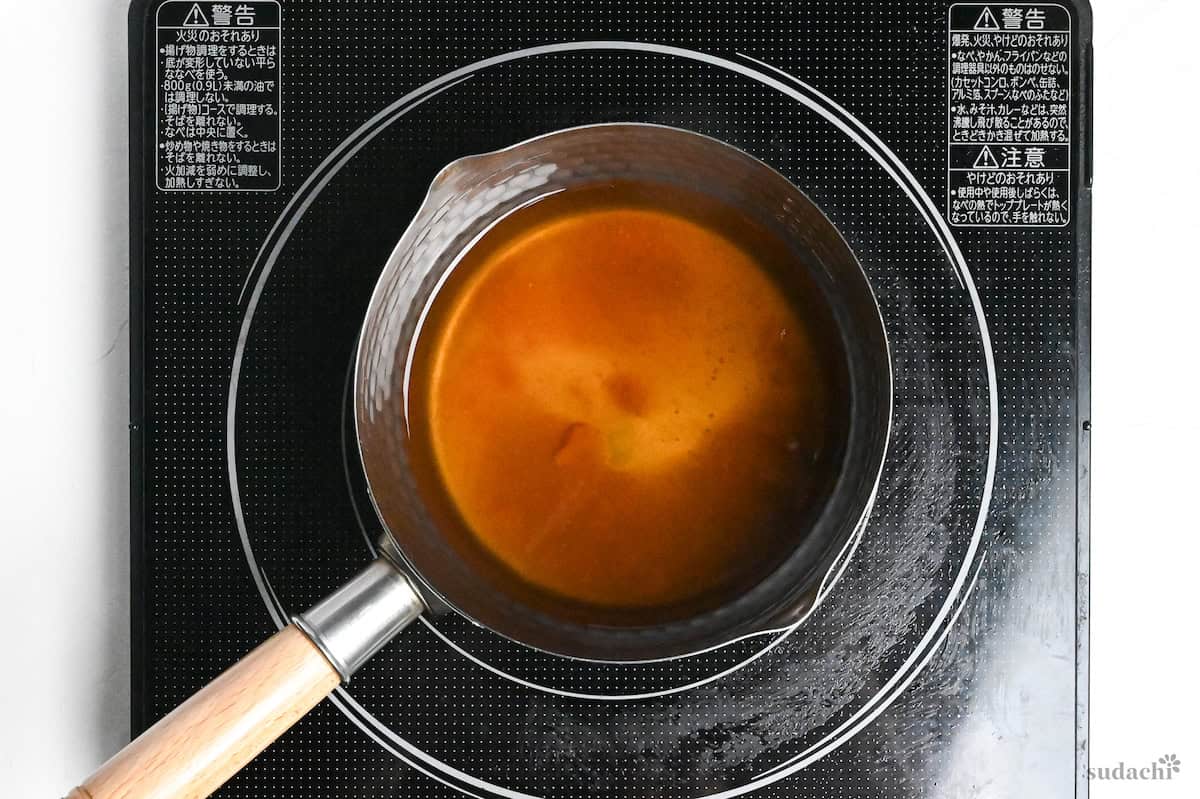
Once the sugar disappears, pour in the light soy sauce and give it one final stir.
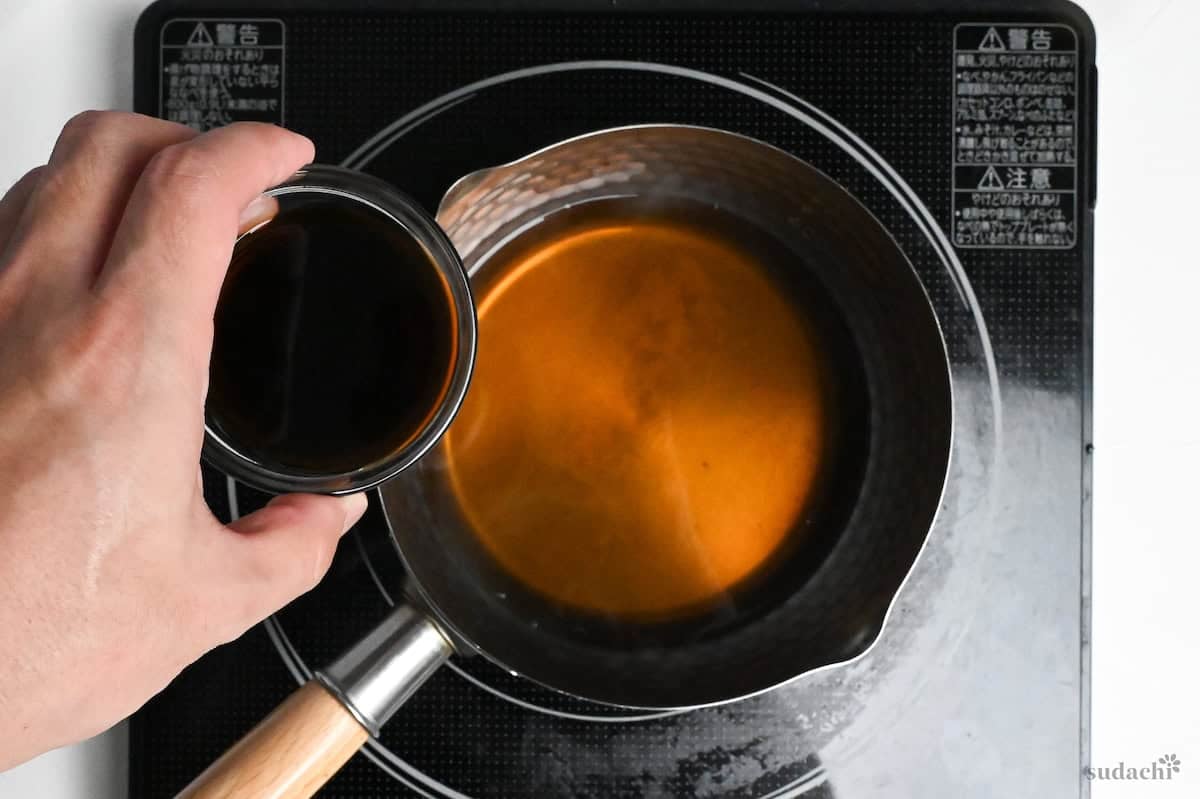
Japanese light soy sauce (usukuchi shoyu) keeps your aburaage a beautiful golden amber instead of deep brown. The color difference might seem minor, but it’s the visual cue that separates homemade from store-bought.
If you only have regular soy sauce at home, don’t worry! Your pouches will taste fantastic, just with a darker, more rustic appearance.
Heat your seasoning mixture until it just begins to bubble around the edges, then reduce to a gentle simmer. Add the prepared abura-age pieces and cover with a drop lid to keep them submerged in the liquid.
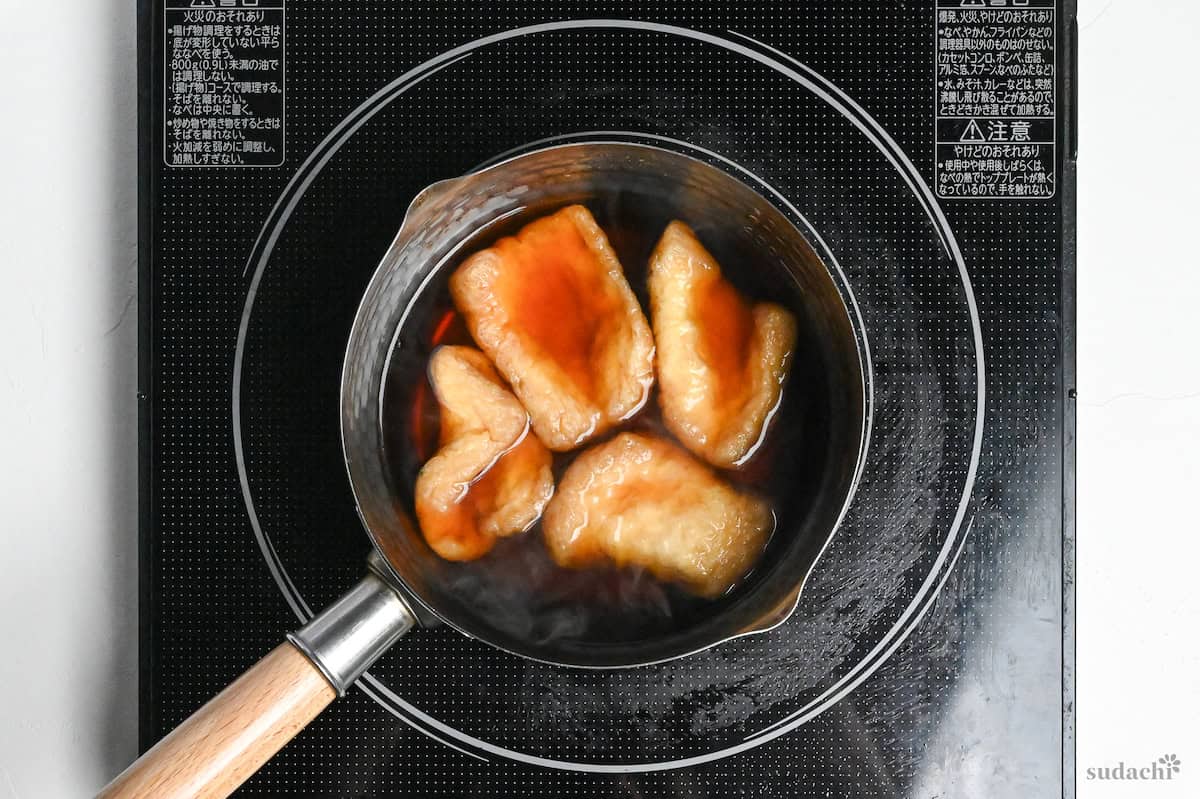
Let them simmer with drop lid on for 15 minutes, or until the cooking liquid reduces by about two-thirds.
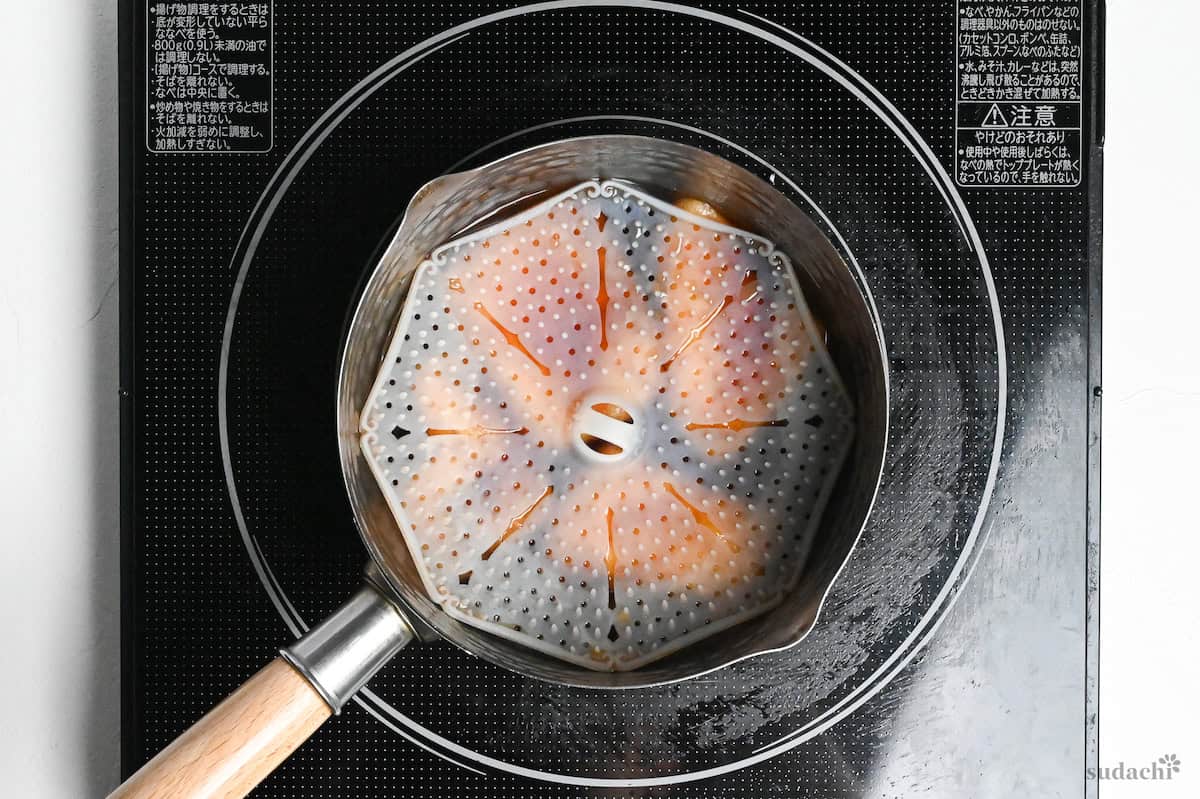
Transfer the seasoned aburaage to a storage container along with any remaining cooking liquid, then let them cool to room temperature.

Once cooled, refrigerate for at least 3-4 hours with either plastic wrap or paper towel for even marination.
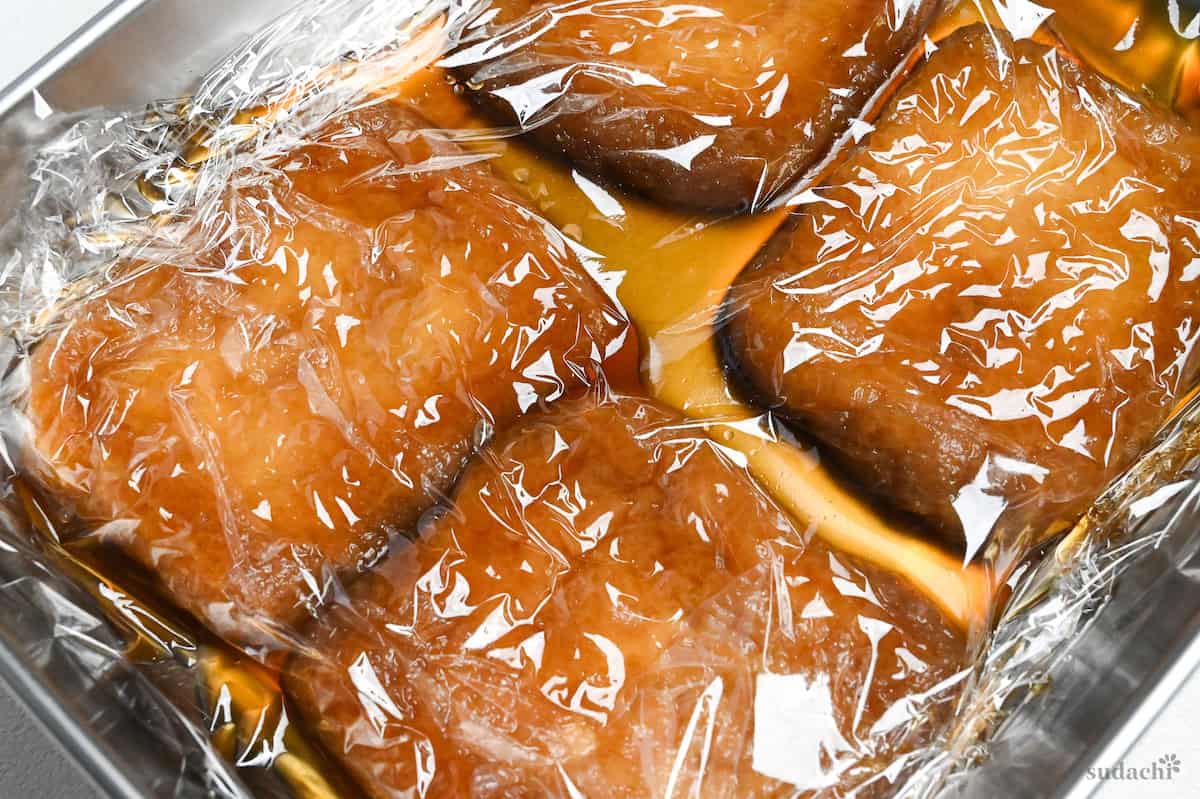
Then, put the lid on.
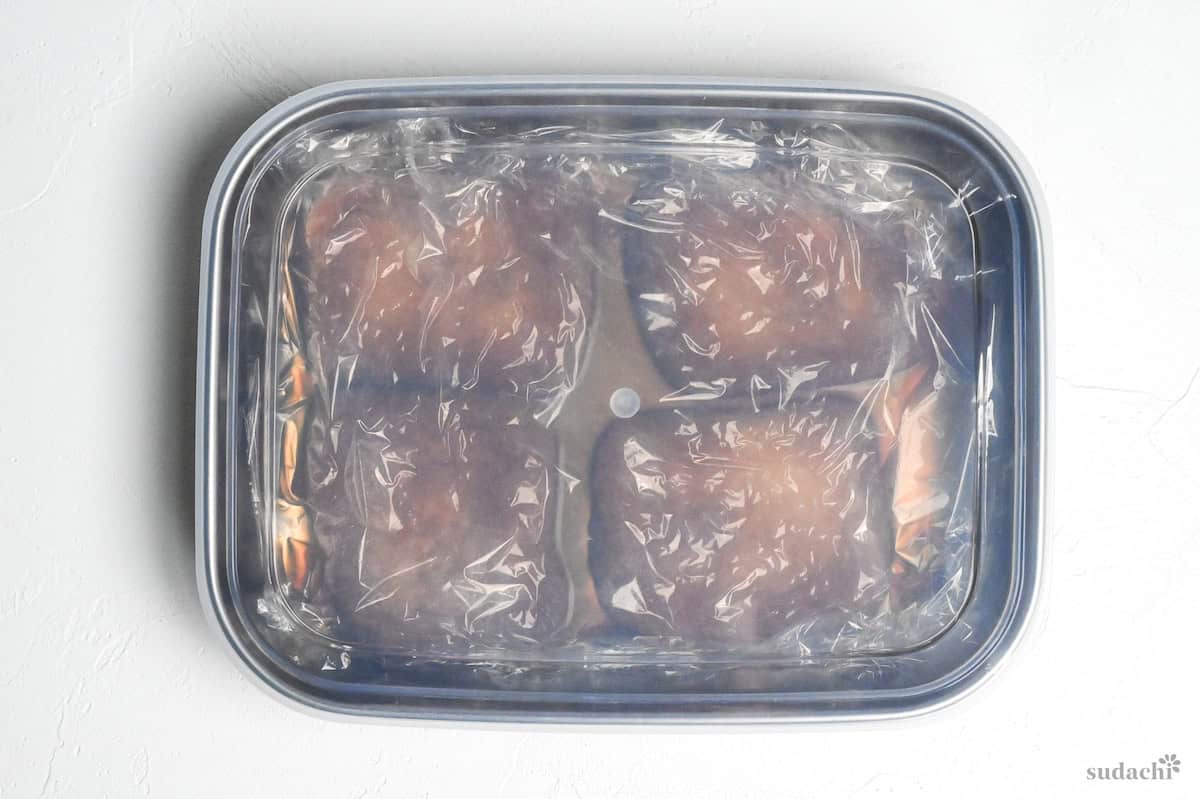
Don’t let your eagerness for perfect flavor lead you astray! These pouches hit their peak after one night in the fridge. Leave them longer than 24 hours and they’ll become overly rich with a mushy texture that won’t hold up in your finished udon bowl.
Pour the dashi stock, light soy sauce, mirin, and light brown sugar into a medium saucepan and whisk until the sugar dissolves completely. Bring the mixture to a medium-heat boil and let it bubble for exactly 1 minute. This brief boil burns off the alcohol in the mirin while preserving its subtle sweetness.

Turn off the heat immediately and drop in several ice cubes to crash-cool the broth. This quick-chill method halts the cooking process while giving you perfectly balanced, ready-to-serve soup in minutes.

Boil the noodles according to the package, drain, and rinse under cold water until they feel springy and cool to the touch.

Toss them with a few ice cubes right in the colander for extra chill.
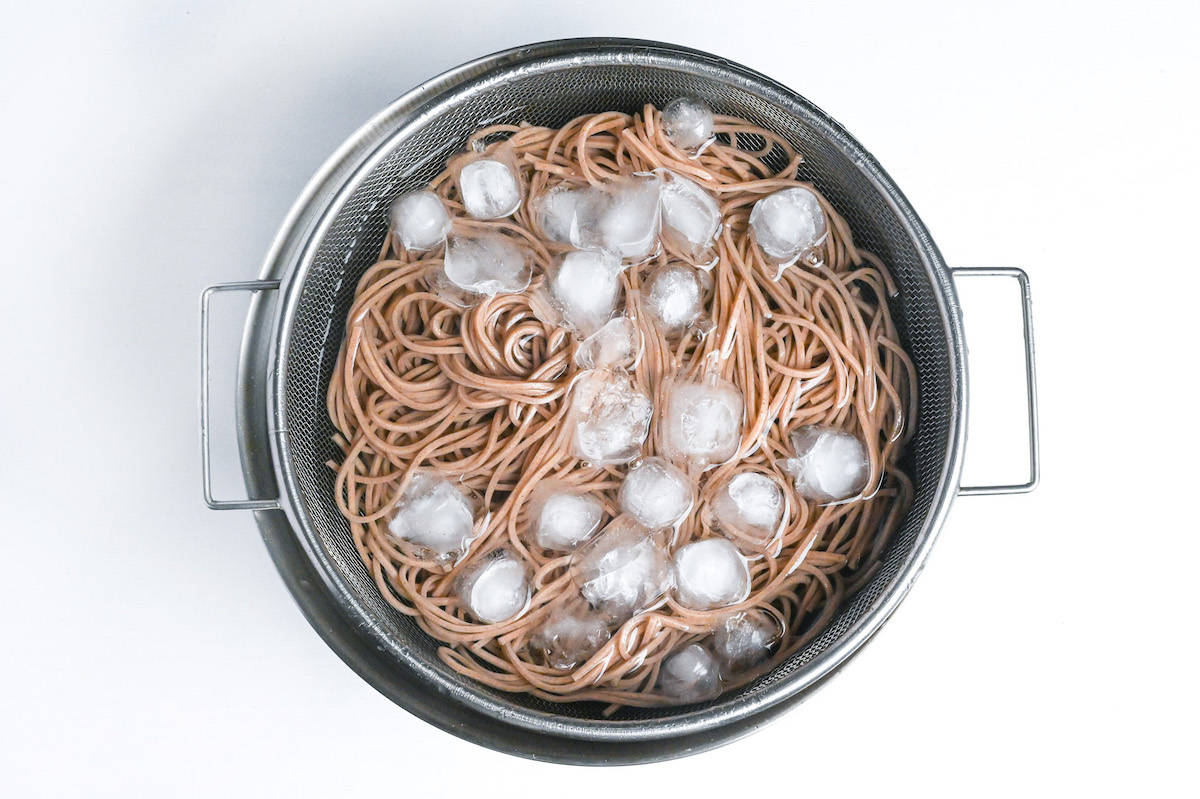
Divide the chilled soba noodles between two serving bowls and pour the cold dashi broth around them. Arrange your toppings in colorful sections:
- Julienned cucumber
- Thin slices of kamaboko fish cake
- Halved soft-boiled eggs
- Perfectly seasoned kitsune aburaage
Finish with a generous sprinkle of chopped green onions and a light dusting of shichimi togarashi for some gentle heat.
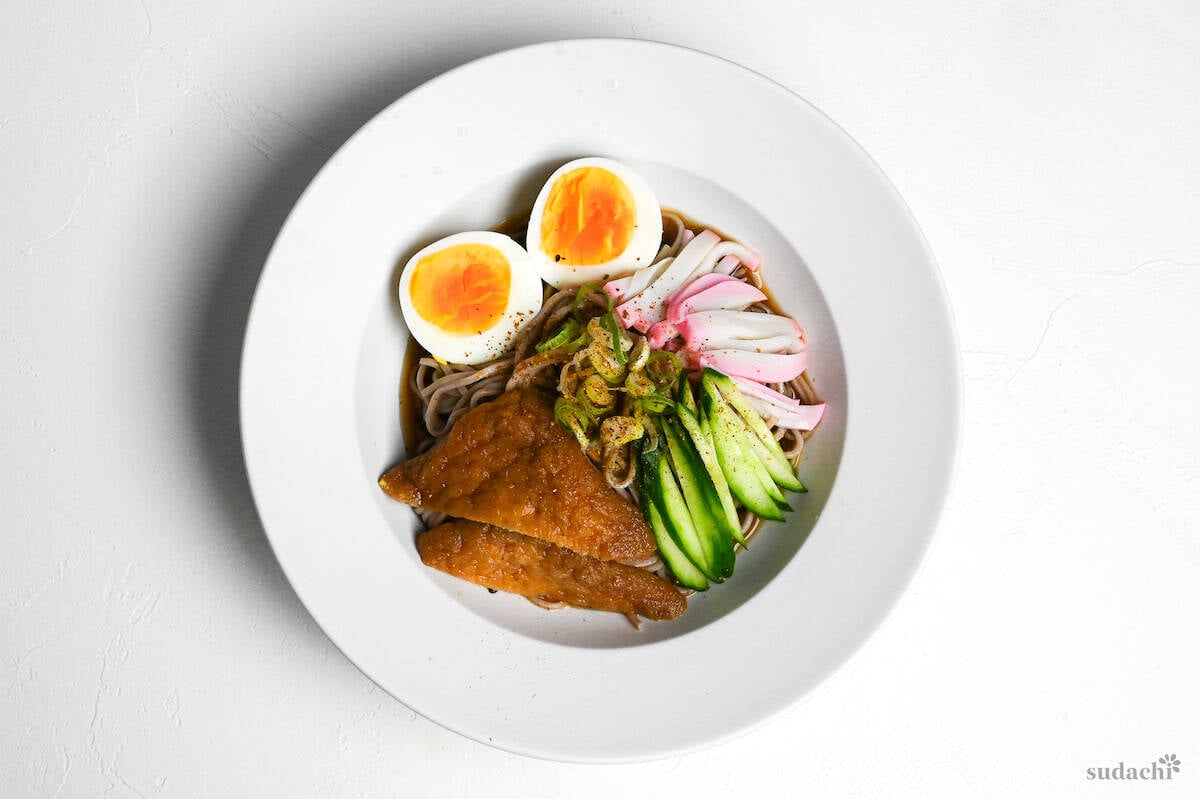
As you eat, don’t hesitate to customize each bite. Try adding a splash of toasted sesame oil, some crunchy tenkasu (tempura bits), a dab of wasabi, or a drop of chili oil to mix things up in one serving.


Essential Tips & Tricks
- Use a drop lid to keep the aburaage fully submerged while simmering.
- Always rinse and gently squeeze the aburaage after boiling to prevent greasy or watery results
- Chill the seasoned aburaage for at least 3 hours (preferably overnight) for the best taste and texture.
- Don’t oversoak the seasoned aburaage. Peak flavor happens after overnight chilling, but beyond 24 hours they become too salty and mushy.
- Assemble toppings just before serving to preserve texture and visual appeal.
With these simple tips in mind, you’re set for success every time you make hiyashi kitsune soba.
Meal Prep & Storage
This hiyashi kitsune soba recipe is partially suitable for meal prep, with the seasoned aburaage being the perfect make-ahead component.
- Component Prep Only: The seasoned aburaage (kitsune) can and should be made 1 day ahead, but not longer. The cold dashi broth can also be prepared up to 2 days in advance and kept chilled.
- Fresh Assembly Required: The soba noodles must be cooked fresh and served immediately after chilling. Pre-cooked noodles become mushy and lose their essential texture, even when stored properly.
- Storage Guide: Store seasoned abura-age in airtight containers with their cooking liquid for up to 24 hours maximum, beyond this they become oversalted. Keep the cold dashi broth refrigerated in a sealed container for up to 2 days.
Serving Suggestions
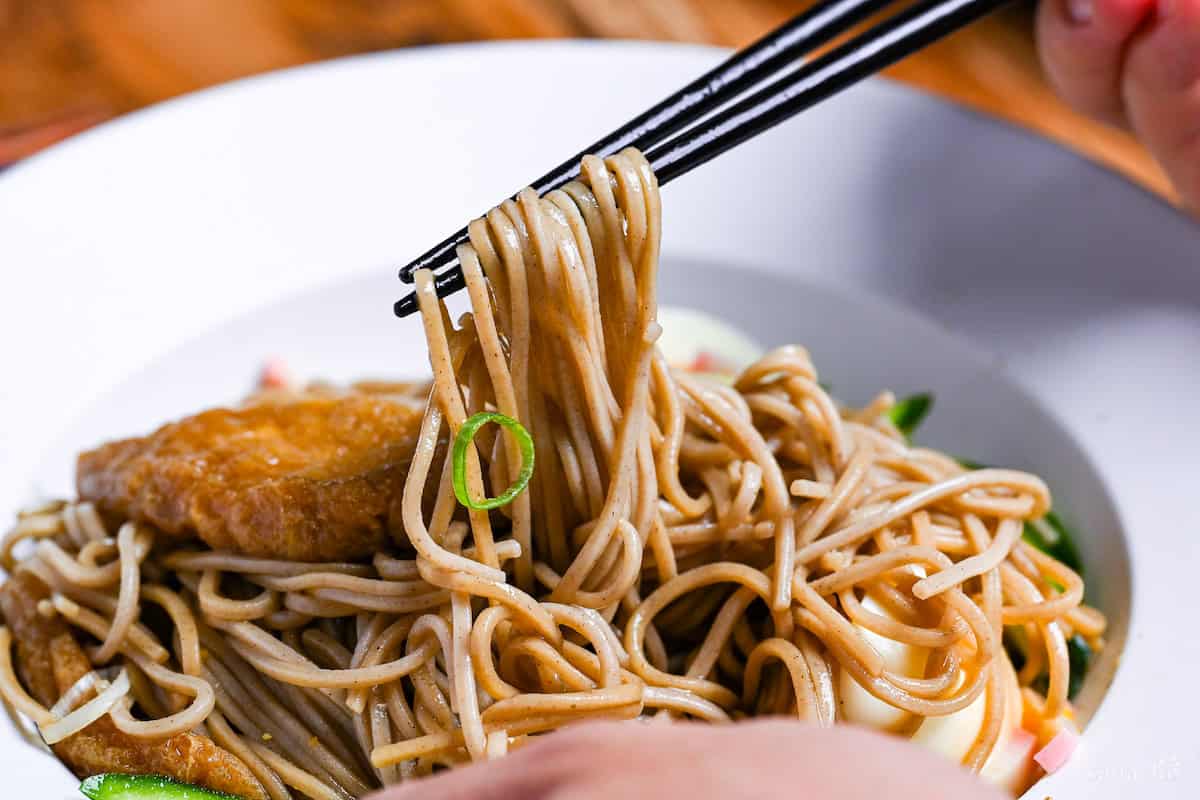
Did You Try This Recipe?
I would love to hear your thoughts!
💬 Leave a review and ⭐️ rating in the comments below. 📷 I also love to see your photos!
More Summer Noodle Recipes
- Hiyashi Tantanmen (Cold Spicy Ramen Noodles)
- Hiyashi Chuka
- Zaru Ramen (Cold Dipping Ramen)
- Summer Vegetable Soba Noodles
Hungry for more? Explore my summer noodle recipe collection to find your next favorite dishes!
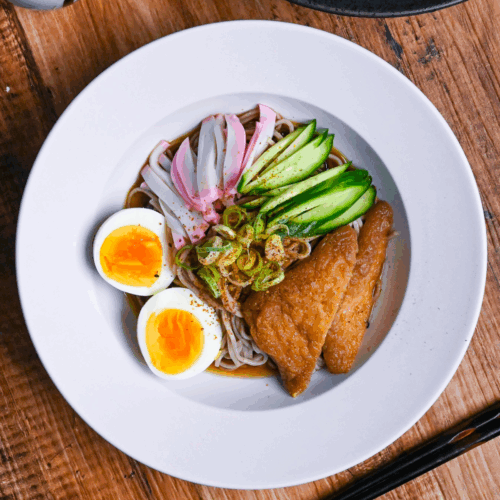
Hiyashi Kitsune Soba (Cold Buckwheat Noodles with Marinated Fried Tofu)
Ingredients
Kitsune
- 4 pieces fried tofu pouch (aburaage)
- water for blanching
- ½ tsp salt for blanching
- 150 ml dashi stock use kombu/shiitake dashi to make it plant-based
- 2 tbsp mirin
- 2 tbsp sugar I used light brown sugar
- 1 tbsp sake
- 2 tbsp Japanese light soy sauce (usukuchi shoyu) or regular soy sauce*
Soba
- 4 portions dry soba noodles
- 120 ml dashi stock use kombu/shiitake dashi to make it plant-based
- 6 tbsp Japanese light soy sauce (usukuchi shoyu) or regular soy sauce
- 2 tbsp mirin
- 2 tsp sugar I used light brown sugar
- 6-8 ice cubes medium size
Toppings
- 4 slices kamaboko fish cake omit for plant-based
- 1 Japanese cucumber julienned
- 4 boiled eggs halved
- finely chopped green onions
- Japanese chili powder (shichimi togarashi)
My recommended brands of ingredients and seasonings can be found in my Japanese pantry guide.
Can’t find certain Japanese ingredients? See my substitution guide here.
Instructions
Making Kitsune (Skip if using store-bought)
- Bring a pot of water to a rolling boil and add ½ tsp salt. Mix to dissolve, then add 4 pieces fried tofu pouch (aburaage).

- Weigh down the aburaage with a drop lid or a weight on top of foil to keep them submerged and let them boil for 3 minutes.

- Drain and wash the aburaage with cold water to cool them. Gently squeeze out the liquid, being careful not to tear them.

- Take a saucepan and add 150 ml dashi stock, 2 tbsp mirin, 2 tbsp sugar, and 1 tbsp sake. Heat over medium while mixing until the sugar dissolves, then add 2 tbsp Japanese light soy sauce (usukuchi shoyu).

- When the mixture starts to bubble around the edges, reduce the heat to a simmer and place the aburaage in the pot.

- Cover with a drop lid to submerge them in the mixture and simmer for 15 minutes or until the liquid has reduced by two-thirds.

- Transfer the contents of the saucepan to a sealable heatproof container and leave to cool to room temperature.

- Once cooled, place plastic wrap or kitchen paper directly on the surface of the aburaage and seal the container with a lid. Rest in the fridge for 3-4 hours, or up to 24 hours max.

Noodles & Broth
- Take a saucepan and add 120 ml dashi stock, 6 tbsp Japanese light soy sauce (usukuchi shoyu), 2 tbsp mirin, and 2 tsp sugar. Boil for 1 minute to burn away some of the alcohol in the mirin.

- Turn off the heat and add 6-8 ice cubes to cool and dilute the concentrated broth.

- Boil a large pot of water and cook 4 portions dry soba noodles according to the package instructions.

- Drain the cooked soba and wash with cold water, then place in a bowl of ice water to chill completely.

- Drain and divide the noodles between serving bowls. Pour the sauce around them, then cut the marinated tofu pouches in half diagonally into triangles and place them on top of the noodles. Top with julienned cucumber, kamaboko fish cakes, halved boiled eggs, finely chopped green onions and Japanese chili powder (shichimi togarashi).

- Mix well before eating and enjoy!

Notes
- Japanese dark soy sauce (koikuchi shoyu) can be used as a substitute for light soy sauce, but the result will be darker with a deeper soy-flavor.
- Note: The nutritional information includes the full serving of broth & marinade. Most people in Japan don’t actually finish all the soup.
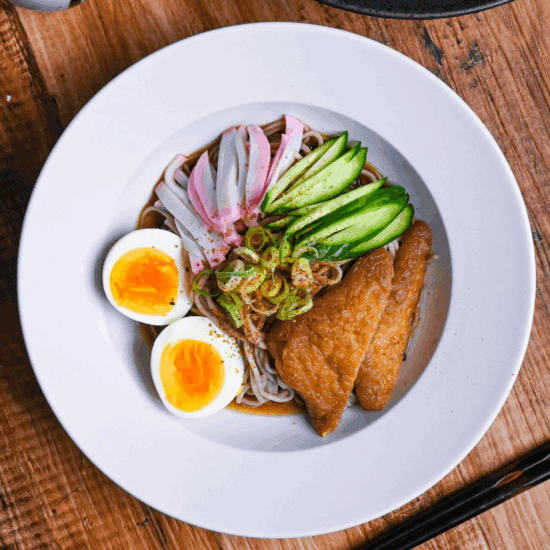


Leave a rating and a comment